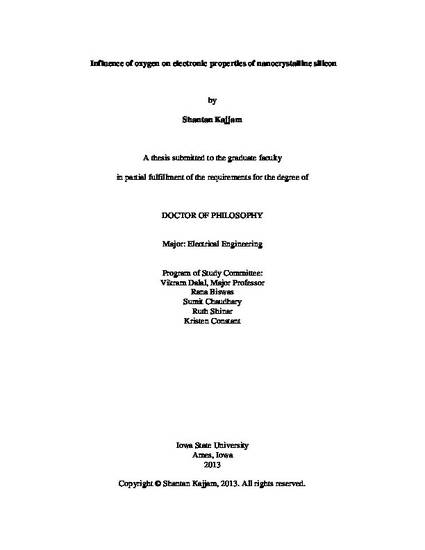
Nanocrystalline Silicon (nc-Si) is an important material for photovoltaic device applications. Its excellent absorption, low defect levels and many other interesting properties help build high efficiency solar cells. Its structure is very complex and is sensitive to contaminants and fabrication processes. It needs a careful study so that a maximum outcome can be attained from the material.
Nc-Si is highly prone to be defective and oxygen is one of the major sources of the defects. In this thesis, systematic analysis of the fundamental properties of oxygen doped & boron compensated nc-Si are illustrated. Thin film solar cells were fabricated using Plasma - Chemical Vapor deposition and various electrical & structural measurements like Capacitance - Voltage, Capacitance - Frequency, Reverse Recovery transient lifetime, diffusion length, Dark IV, Light IV, Quantum Efficiency, Raman etc. have been measured to probe the properties of the material.
We show that oxygen in nc-Si increases both shallow and deep defect densities, with the shallow defects peaking at 0.35-0.4 eV and deep defects peaking at ~0.55 eV below the conduction band. These energetic locations are similar to energies for oxygen induced defects in crystalline Si. The minority carrier lifetime is found to be inversely proportional to defect density which follows SRH recombination theory. Dark IV has been measured and excellent correlation with defects has been witnessed.
Oxygen degradation can be compensated by Boron doping and systematic analysis of various fundamental electronic properties has been done to understand the process of this compensation. It has been observed that boron incorporation helps reduce the defects induced by oxygen, recovers lifetime and ultimately the efficiency of the solar cell.
Variation in defects with changing grain size and crystallinity has been briefly discussed. Various applications of CF based measurement with amorphous Silicon, amorphous Silicon Germanium, nc-Si/a-SiGe novel superlattice devices and organic cells have been evaluated and shown that CF certainly is a useful method to characterize the samples. Effect of MESA etching on the improvement of capacitance measurements is also presented.
In the process of efficiently characterizing nc-Si, an excellent denoising technique using wavelet analysis has been developed to remove noise in defect profile measurements. Careful analysis of Carrier lifetime data has also been developed. Low frequency, high temperature capacitance measurements has also been extensively used without noise issues.
Available at: http://works.bepress.com/shantan_kajjam/1/